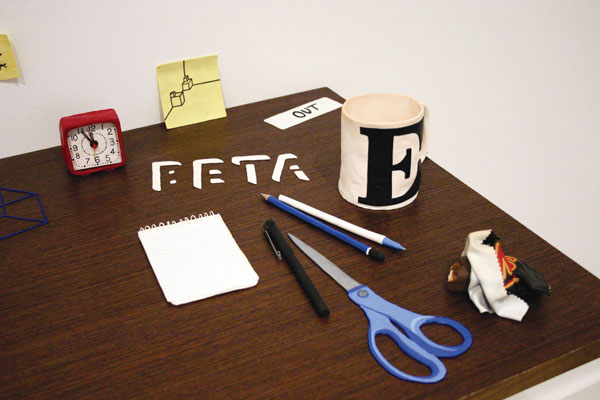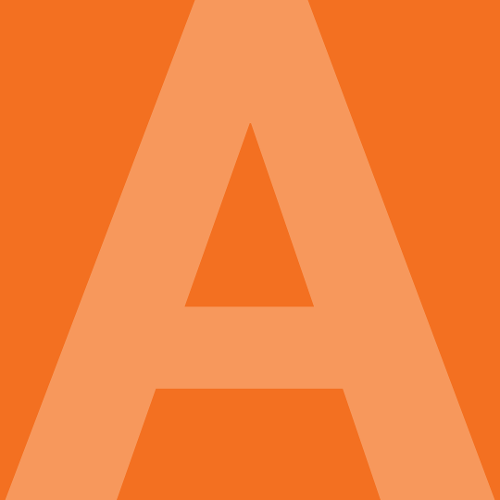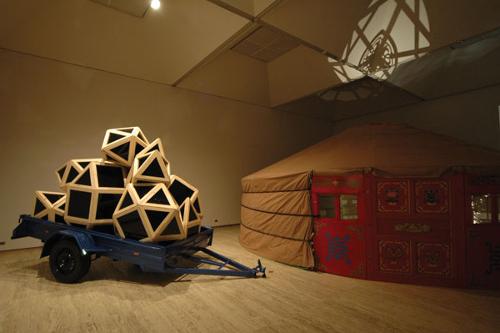
Emma White's recent work as exhibited at MOP Projects in Sydney is both witty and incisive. The exhibition consists of two sculptural installations in conversation with a series of photographs and draws a sophisticated line of enquiry from the concept of a tautology as a linguistic redundancy to the involution of various frameworks through which we read and understand art.
Taking as a point of departure the artistic trope of the still life, the focal work, Delaying tactics for the intuitive researcher (2007), reproduces a fictionalised scenario of the artist's working space. Using the synthetic modelling clay Fimo White creates meticulous replicas of banal desktop ephemera and studio tools – an in-tray, nail polish, paper clips, pens, notepad, scissors, and so on – laid out in a contrived composition of casual idleness.
Remade in their own image, the objects create a sense of disjuncture: easily recognisable and hence instantly perceived, their identity as artefacts is only revealed upon close inspection. Compelling the viewer towards a self-conscious and attentive curiosity, other facets of the piece consequently reveal their ambiguous relation to one another, and to the external world. The desk – in fact a shelf covered in faux wood-grain laminate – becomes a platform for the elaborate restaging of signs in a constant cycle of allusion to their referents. Here the real and the copy collapse in upon themselves through the overtly tactile, handcrafted qualities of White's sculptures and the denial of their intended functionality.
The other significant component of this work is White's inclusion of text, also fashioned from Fimo, in various guises on Fimo pages and post-its, and made as independent objects with perspectival lines used to suggest three-dimensional form. Alongside the aforementioned objects as images, these words-as-objects cast into relief the theme at the heart of the exhibition: an investigation of organisational and interpretive systems.
In Tautology, multiple incarnations of language are inter-implicated. Words become concrete forms, objects perform as images, and the language of behaviour is rendered visible. The latter is achieved in Delaying tactics through White's representation of the work's making beyond the usual markers of 'process'. A half-eaten Mars bar and empty coffee cup, an actually ticking clock, expended pill packaging, and a crossword puzzle all point to the more personal facet of production with a wry yet charismatic realism.
Psychological states of distraction, boredom and procrastination, along with the passage of time and bodily processes, are interwoven with the practical aspects of process projected onto the finished piece by the viewer.
The language of art making is additionally dismantled by way of White's perceptive interrogation of the margins between genres and mediums, namely photography, sculpture and painting. Extending the doubling tendency inferred by the show's title, three photographs reiterate a still life of Fimo vessels installed nearby, referencing Giorgio Morandi's famous images of generic domestic vessels in contextual voids. Where the objects in Delaying tactics are explicitly scaled 1:1, here White radically manipulates scale by making the arrangement of vessels miniature in the extreme, then photographing them to appear larger than life-sized. These images, titled Tautology 1-3 (after Morandi) (2007), emphasise photography's capacity to undermine the documentary authority with which it is commonly associated. However, they also enact a blurring of aesthetic qualities across genres that is a broader feature of the show.
White's photographs are distinctly painterly, just as her objects and installations might be thought of as photographically conceived. Pointing to cracks and slippages in the logic of representational systems and the categories by which we read art making, White's exhibition functions as a semantic investigation of sorts. Each component of the show is astutely indexed to another. In part, this continual layering and reflexive feedback functions to highlight the relationship between different facets of White's own practice. Tautology also thoughtfully reveals a particular grammar of making, presenting and reading art, opening out their parameters for evaluation and review.












